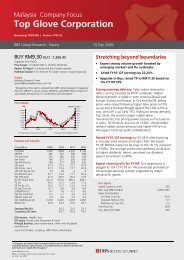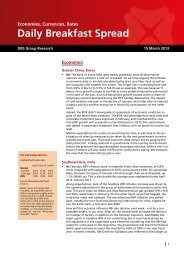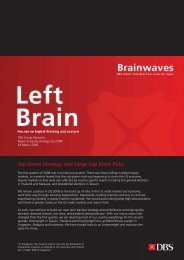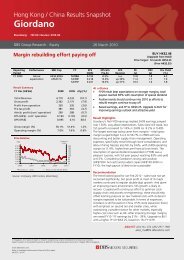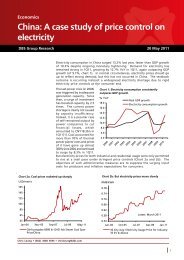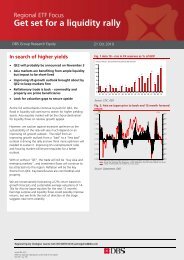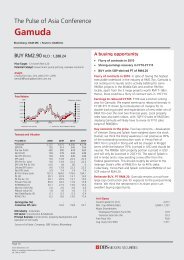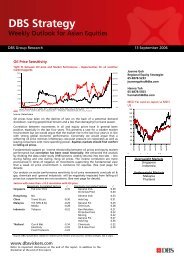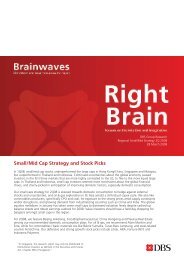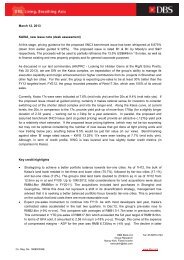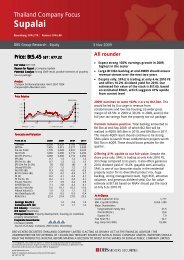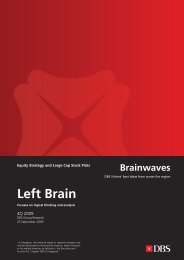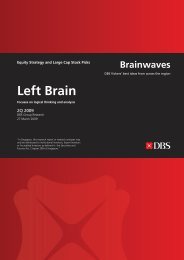Economics Markets Strategy - the DBS Vickers Securities Equities ...
Economics Markets Strategy - the DBS Vickers Securities Equities ...
Economics Markets Strategy - the DBS Vickers Securities Equities ...
You also want an ePaper? Increase the reach of your titles
YUMPU automatically turns print PDFs into web optimized ePapers that Google loves.
<strong>Economics</strong>: Taiwan<br />
<strong>Economics</strong> – <strong>Markets</strong> – <strong>Strategy</strong><br />
Investment<br />
recovery is likely to<br />
sustain<br />
The negotiations<br />
with China on<br />
tourism and<br />
transportation<br />
issues are<br />
progressed<br />
smoothly<br />
Still, growth drivers on <strong>the</strong> way<br />
Despite <strong>the</strong> downside risks caused by inflation, we maintain our 2008 GDP forecast<br />
unchanged at 5.0%, as we think <strong>the</strong> new government’s policy stimulus will<br />
bode well for a sustained investment recovery in 2H08.<br />
The blueprint planned by <strong>the</strong> new government centers on streng<strong>the</strong>ning economic<br />
ties with China and promoting infrastructure investment in <strong>the</strong> island. The new<br />
president Ma Ying-jeou has pledged to establish weekend direct charter flights<br />
and allow <strong>the</strong> direct entry of tourists from China starting from July. As we pointed<br />
out previously, <strong>the</strong>se two are relatively mature proposals reflecting improving<br />
cross-strait economic relations, as <strong>the</strong> negotiations on related technical details<br />
have already moved forward over <strong>the</strong> last two years. Since <strong>the</strong> ending of presidential<br />
elections in March, interactions between Taiwan’s new leaders and China’s top<br />
government officials have been warm. The bilateral dialogue between <strong>the</strong> semiofficial<br />
Straits Exchange Foundation (Taiwan) and <strong>the</strong> Association for Relations<br />
across <strong>the</strong> Taiwan Strait (China), which has been suspended for almost a decade,<br />
is now scheduled to resume on June 11-14. The weekend charter flights and<br />
tourism issues will be <strong>the</strong> focus of this meeting, and a formal official agreement<br />
is likely to be formulated successfully according to newswire reports. We stay<br />
optimistic in this regard. Tourism revenue alone (brought by 3000 China tourists<br />
per day) is estimated to add annual GDP growth by 0.4ppt (Chart 5). The positive<br />
effect on investment, employment and income growth in related industries<br />
would be even more significant.<br />
Chart 5: Tourism revenue to grow<br />
%<br />
2.0<br />
1.5<br />
1.0<br />
0.5<br />
Visitors Arrivals (RHS)<br />
Tourism revenue/GDP<br />
mn,<br />
persons<br />
6<br />
5<br />
4<br />
3<br />
2<br />
1<br />
Chart 6: Saving-investment gap widening<br />
%<br />
31<br />
29<br />
27<br />
25<br />
23<br />
21<br />
19<br />
17<br />
Saving / GDP<br />
Investment / GDP<br />
0.0<br />
1991 1994 1997 2000 2003 2006 2009F<br />
0<br />
15<br />
1997 1999 2001 2003 2005 2007<br />
Infrastructure<br />
investment could<br />
be funded through<br />
<strong>the</strong> private sector<br />
The new president also promised to promote <strong>the</strong> “I-Taiwan 12 infrastructure<br />
projects” over <strong>the</strong> next eight years, which amount to a total of TWD 4trn (3% of<br />
GDP per year). We concur that investment is a much-needed driver for Taiwan’s<br />
economy. The external-internal imbalance has widened for years - trade surplus<br />
stayed persistently strong, but investment has been massively relocated overseas<br />
due to sluggish confidence on domestic politics and <strong>the</strong> long-term trend of<br />
globalization. As a result, <strong>the</strong> saving-to-investment gap has widened sharply,<br />
from 2.8% (of GDP) in 2000 to 9.5% in 2007 (Chart 6). It is true that <strong>the</strong> infrastructure<br />
investment plan targeted by <strong>the</strong> government appears somewhat ambitious in<br />
light of its still-weak fiscal position (-0.2% of GDP in 2007) and rising fiscal<br />
burden resulting from fuel subsidies this year. Never<strong>the</strong>less, we think <strong>the</strong> official<br />
proposal of raising 1/3 funds from <strong>the</strong> private sector (via <strong>the</strong> BOT model) is<br />
feasible. Moreover, <strong>the</strong> leading role played by <strong>the</strong> government in increasing<br />
84



